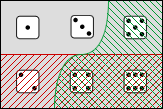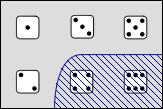
|

|
| A | B |
Fig. 4.1.1-1. Propositions expressed by two sentences (A) and their disjunction (B).
Although, as was noted in 3.1.4, conjunction and negation alone suffice to give us the effect of any connective for which a truth table can be given, these two are not the only connectives that are marked by special vocabulary in English. We will introduce special notation for two of them. The first is expressed by the English word or. This word has a range of grammatical uses comparable to those of and. It can join words and phrases with various grammatical functions, and the force of most of these uses can be captured by a use of or to join sentences. For example,
The weight is at or near the limit
can be paraphrased as
The weight is at the limit or the weight is near the limit
The connective that we will use to analyze sentences of the form φ or ψ is called disjunction; we will use the symbol ∨ (the logical or) for it and represent it also with the English notion either ... or (in which either plays a role like that of both). As in the case of conjunction we will sometime use a special term for the components of a disjunction: they are disjuncts.
The effect of disjoining a sentence with another is to back off from a definite claim by leaving open a second alternative. The sentence above, instead of asserting The weight is at the limit in an unqualified way, adds the alternative The weight is near the limit to leave open a further range of possibilities. In general, we can regard a sentence φ ∨ ψ as leaving open all possibilities left open by φ as well as all those left open by ψ. As a result, a disjunction φ ∨ ψ says less than either of the components φ and ψ, and the difference can be extreme—as in the cowardly weather forecast It will rain tomorrow, or else it won’t. Since φ ∨ ψ leaves open more possibilities than either φ or ψ, it rules out fewer and has less content. In particular, it rules out only those possibilities that are ruled out by both φ and ψ; and we can say that the content of φ ∨ ψ is the common content of φ and ψ, the content shared by the two. For example, the following sentences are roughly equivalent
The temperature was very hot or very cold
The temperature was extreme
and the second expresses the common content of The temperature was very hot and The temperature was very cold, the two components of the first.
Disjunction, then, adds the possibilities left open by one component to those left open by the other and selects as the possibilities ruled out those that are ruled out by both components. This is shown in Figure 4.1.1-1 below. The pictures of dice have the same significance as in Figure 2.1.1-1: they indicate regions consisting of the possible worlds in which a certain die shows one or another number. The proposition shown in 4.1.1-1B is The number shown by the die is odd ∨ the number shown by the die is less than 4 and 4.1.1-1A illustrates its two components.

|

|
| A | B |
Fig. 4.1.1-1. Propositions expressed by two sentences (A) and their disjunction (B).
The possibilities ruled out by the components are shown in 4.1.1-1A hatched in different directions and different colors. 4.1.1-1B then shows the reduced set of possibilities ruled out by the disjunction and the enlarged set that are left open.
We can use these ideas to describe the truth conditions of disjunctions. If φ ∨ ψ is to leave open all possibilities left open by φ as well as all those left open by ψ, it must be true in all cases where φ is true and also in all cases where ψ is true. And if φ ∨ ψ captures the content common to φ and ψ—if it rules out the possibilities ruled out by both—it must be false whenever both φ and ψ are false. This is enough to tell us that disjunction is a connective with the table below. That is, φ ∨ ψ is true whenever at least one of φ and ψ is true and is false only when both are false.
| φ | ψ | φ | ∨ | ψ |
| T | T | T | ||
| T | F | T | ||
| F | T | T | ||
| F | F | F |
This table should be compared to the diagram above; the worlds covered by the four rows of the table appear in 4.1-1A as the four regions at the top left and right and bottom left and right, respectively when φ rules out world at the bottom of the rectangle and ψ rules out worlds at the right.